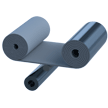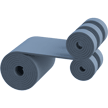Capabilities for Custom Manufacturing
Water Jetting
2D prototypes, low volumes, design changes and tight tolerances are no problem with our high speed waterjet cutting system. A very small stream of water traveling at supersonic speed can cut many layers of almost any high temperature insulating, and leaves the material almost dry. Our system is highly customized to meet the challenges of cutting your insulation economically.
Vaccum Forming
3D ceramic fiber shapes can be molded using our custom vacuum forming machines. This process is ideal for higher volume parts that need to be molded to net shape economically. Tooling is required, which we design and fabricate. Custom material properties can be formulated to achieve your required temperature rating, density and hardness.

Laminating
The laminating process can adhere two different materials. The formulation of the adhesive can be changed to meet various end use requirements. Two different materials can be combined to achieve a hybrid insulating material that has superior performance parameters.

Slitting
Roll stock sizes are normally 24” or 48” wide which may not be the most convenient size for your application. These larger rolls can be slit down to virtually any combination of sizes. 1” wide slits in full length rolls and can be achieved, and narrower slits can also be produced if we reduce the strip length.
CNC Machining
A versatile way of producing 3D shapes with tight tolerances and intricate details. The process is very precise and produces complicated shapes from almost any material. CNC Machining is time consuming and may have significant material waste.
Casting
Dense refractories can be cast into shapes. Our tool shop can design and fabricate molds from steel, wood or other composite materials depending on the number of uses the mold is expected to last. Refractory shapes can be cast with a range of materials from light weight insulating castables to denser refractories.
Die Cutting
High quality steel rule dies can cut to within tolerances of +/- 0.010”. Die cutting is ideal for larger quantity runs where the design of the piece is unlikely to change so that the tooling cost can be amortized over the full life of the die. Steel rule die cutting is a faster and cleaner way of manufacturing gaskets and seals, but as the material thickness increases die cutting has a harder time holding tight tolerances.
